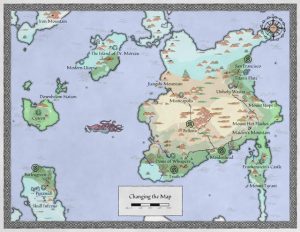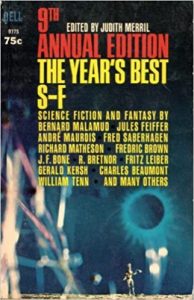The great thing about the metaphorical map of speculative fiction is the sheer variety of landscape. Some stories are great mountain ranges, enormous peaks of books that you ascend, book after book, hiking over hundreds of thousands of words. And then there’s the land of Anthologia, located in the realm of Short Fiction, where you can take a stroll, or a quick jog, through the fantastic.

Venture into that area, and you will find forests of words, each tree a short story. The map of speculative fiction was built in a large part on the early appetite for the fruits of these trees — the pulps of the 30s and on. But the genre gained respectability through the anthologies — and one of the most influential early editors was Judith Merril.
 Born Judith Josephine Grossman, she took the pen name of Judith Merril in 1945. An American (and then Canadian) science fiction writer, editor, and activist, she wrote only three novels (two jointly written with C.M. Kornbluth), but published 26 short stories, and was the editor of numerous anthologies, including the Year’s Best from 1956 to 1967.
Born Judith Josephine Grossman, she took the pen name of Judith Merril in 1945. An American (and then Canadian) science fiction writer, editor, and activist, she wrote only three novels (two jointly written with C.M. Kornbluth), but published 26 short stories, and was the editor of numerous anthologies, including the Year’s Best from 1956 to 1967.
The Realm of Short Fiction is an important area of the map. Short stories are forests of wonders that can whack you upside the head. The flora of the short story can be bold and experimental, occupy more spaces of weirdness, and is allowed to more often defy the preconceptions of what the speculative genre can — and should — be. For the reader, they are a way to escape and be challenged, swiftly. They’re easier to hold in the head, to examine reality from different angles. For the writer, they’re a way to learn, to experiment, and to play.
Anthologies collect these works, amplifying themes (such as Marion Zimmer Bradley’s Sword and Sorceress series), allow authors to play together in a world (George R.R. Martin’s Wild Cards series or Robert Asprin’s Thieves World), or challenge the definitions of speculative fiction itself — who can write it, and who is reading it.
Judith Merril stands as one of the great gatekeepers of the Realm of Short Fiction and holds the keys to many portals of Anthologia. As one of the first women to shoulder the responsibility of the gatekeeper, she helped establish science fiction as a responsible genre, valuing well-written stories and a sense of wit, and ushered in the New Wave movement of the 1960s — experimental fiction relying more on literary techniques to address social issues — with her edited anthology England Swings SF: Stories of Speculative Fiction (Doubleday 1968).
Through her vision, she changed the landscape, broadening definitions and increasing inclusion.
Gatekeeper diversity is important, because everybody brings their own world view. Editors bring a world view, inherently and without malice, but they do bring it. Different eyes spot different things in the landscape. (See for example all those popular “which animal/word do you see first” quizzes. I see the owl. You?) And thus, different eyes pick different stories.
Want more diversity? Look through another’s eyes, which in this case, is the gatekeeper, who presents the trails you will be following as you hike through the Realm of Short Fiction and the Land of Anthologia.
 A strong feminist, Judith Merril wasn’t afraid to be political. Her anthologies collected the works of marginalized writers from various groups, allowing the map of speculative fiction to expand, broaden, and improve. For many, her anthologies were the first introduction to strong, powerful stories written by women, and acted as portals of experimentation. Her path led the way for other gatekeepers, such as Harlan Ellison’s Dangerous Visions (prompted directly by Merril’s influence), and editors Ellen Datlow, David G. Hartwell, Gardner Dozois, and Jeff and Ann VanderMeer.
A strong feminist, Judith Merril wasn’t afraid to be political. Her anthologies collected the works of marginalized writers from various groups, allowing the map of speculative fiction to expand, broaden, and improve. For many, her anthologies were the first introduction to strong, powerful stories written by women, and acted as portals of experimentation. Her path led the way for other gatekeepers, such as Harlan Ellison’s Dangerous Visions (prompted directly by Merril’s influence), and editors Ellen Datlow, David G. Hartwell, Gardner Dozois, and Jeff and Ann VanderMeer.
Although Judith Merril offered us a vision for the future, there’s still work to be done. Only recently has the speculative fiction map started to include gatekeepers (such as Bill Campbell and Edward Austin Hall) and forests of color, with the rise of Afrofuturism. Afrofuturism occupies an explosively creative area of the map infusing the intersection of African diaspora culture and technology, magically and delightfully blurring the line between fantasy and science fiction, between literary and genre.
 Having editors of color is important, because we all need to see the world through as many sets of eyes as possible. Speculative fiction is the realm of the impossible, the improbable. Its great gift is the ability to play with futures — both those we dread and those we wish for, yearn for, crave. And while the speculative fiction genre as a whole has moved (slightly) forward, there still are not enough editors of color and intersection leading the way, not enough gatekeepers to guide us through their view of the world.
Having editors of color is important, because we all need to see the world through as many sets of eyes as possible. Speculative fiction is the realm of the impossible, the improbable. Its great gift is the ability to play with futures — both those we dread and those we wish for, yearn for, crave. And while the speculative fiction genre as a whole has moved (slightly) forward, there still are not enough editors of color and intersection leading the way, not enough gatekeepers to guide us through their view of the world.
THIS MUST CHANGE. The universe of speculative fiction, this map that I try to describe, is big enough for everyone — it has no boundaries of geography, no rules of physics that can’t be broken, mended, or altered. In 1980, Octavia Butler asked, “Why is Science Fiction so White?” (Go read. Now.)
That the situation has only marginally improved in the last 40 years is unacceptable, especially for a genre devoted to the expansion of realities. Judith Merril and others (Datlow, Hartwell, the VanderMeers) have provided paths for the next generation of gatekeepers. It is well past time that the Realm of Short Fiction and the Land of Anthologia avail themselves of diversity if we’re going to see a future less dystopian than present circumstances.







No Comments